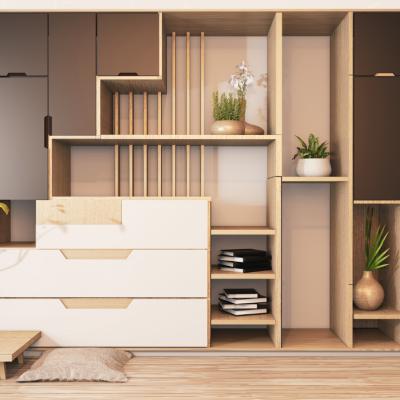Find Reliable Home Service Pros
Start your project today
Free consultations with no obligation.
How Remodel.one works
Tell us about your project
Answer a few easy questions to get matched with the best local pros.
Receive quote
Shortly thereafter you will receive a quote from a trusted contractor in your area.
Get the job done
Don't disrupt your life. Installation usually only takes 1 single day.


 Cabinets
Cabinets
Installing cabinets is an essential part of functional interior design for kitchens and other living areas. In addition to offering essential storage options, cabinets also greatly enhance a room's overall aesthetic appeal. Here, we look at a variety of kitchen cabinets, each with unique features and looks.
 1. Beaded Kitchen Cabinets
1. Beaded Kitchen Cabinets
The inclusion of ornamental molding or beading around the borders of the cabinet doors and drawers is what defines beaded kitchen cabinets. The cabinets' overall attractiveness is improved by this extra element, which adds a touch of refinement and vintage charm.
Planning and Measuring: Precise measurements of the kitchen area are crucial. When arranging cabinets, take into account elements like work surfaces, appliance locations, and general layout.
Material Selection: A range of materials, such as wood, MDF (medium-density fiberboard), or even PVC, can be used to create beaded cabinets. Select a material that fits both your budget and desired look.
Mounting and Adjustment: Tightly fasten hanging rails or cabinet brackets to the wall. Using these supports, hang the beaded cabinets, making sure to align and adjust them properly for a smooth, level look.
 2. Shaker Kitchen Cabinets
2. Shaker Kitchen Cabinets
Shaker kitchen cabinets are distinguished by their uncomplicated and uncluttered design. They often have a recessed center panel and simple construction, which reflects the Shaker design movement's emphasis on functionality and minimalism.
Planning and Measuring: As you measure the kitchen, consider where the sinks, appliances, and other fixtures will go. Arrange things so that efficiency and storage are maximized
Material Selection: Shaker cabinets are frequently made of wood; typical woods to use are oak, cherry, or maple. Select a type and finish of wood that goes well with the kitchen's overall design concept.
Hanging and Leveling: Use the proper brackets or screws to fasten the cabinets to the wall. Make sure the cabinets are level and hung firmly for a unified and polished appearance.
 3. Flat Panel Kitchen Cabinets
3. Flat Panel Kitchen Cabinets
Slab cabinets, sometimes referred to as flat panel kitchen cabinets, have straightforward, flat door panels devoid of raised or recessed accents. This sleek and contemporary look is enhanced by the basic design.
Planning and Measuring: Measure the area in the kitchen and plan the layout, taking into account where the equipment should go and the intended visual flow.
Material Selection: Wood, MDF, or laminate are some of the materials that can be used to create flat panel cabinets. When choosing materials, take affordability, style, and durability into account.
Mounting and Alignment: Using the proper mounting hardware, fasten the cabinets to the wall. Make sure everything lines up perfectly for a smooth look.
 4. Base Kitchen Cabinets
4. Base Kitchen Cabinets
Installed at the floor level, base kitchen cabinets form the framework for other kitchen fixtures such as sinks and countertops. They give the kitchen workspace the necessary support and storage.
Floor Preparation: To support the weight of the base cabinets, make sure the floor is level and stable.
Positioning: Make sure the base cabinets are properly aligned and spaced apart for the appliances and fittings by carefully positioning and fastening them to the wall.
Joining Cabinets: To create a unified and integrated look, attach many base cabinets together with screws or dowels.
 5.Tall-Standing Kitchen Cabinets
5.Tall-Standing Kitchen Cabinets
Tall-standing kitchen cabinets, often called utility or pantry cabinets, are vertically oriented cabinets that reach the ceiling from the floor. Their purpose is to optimize the amount of vertical storage area.
Planning and Measuring: Determine the width and height of the space that will be used for the tall-standing cabinets. Arrange how shelves and other interior elements will be positioned.
Securing to the Wall: For stability, tall cabinets may be fastened to the wall. Make sure you're properly anchored to avoid instability or tipping.
Interior Configuration: To maximize storage, add shelves, pull-out drawers, and other organizing elements to the interior of tall-standing cabinets.



Cabinet Remodeling
In most homes, the kitchen is more than a place to cook meals — it is a central gathering place for eating, studying, crafting, playing games and more. Essentially, the kitchen is the heartbeat of your home. Few things make a kitchen come together more than beautiful cabinetry. While appealing cabinetry showcases your kitchen’s style, nothing makes the space look more unfashionable than outdated, plain or worn-out cabinets.
Related Articles
cabinets
How to paint Kitchen CabinetDo you want to paint your kitchen cabinets by yourself? Do you ne...















